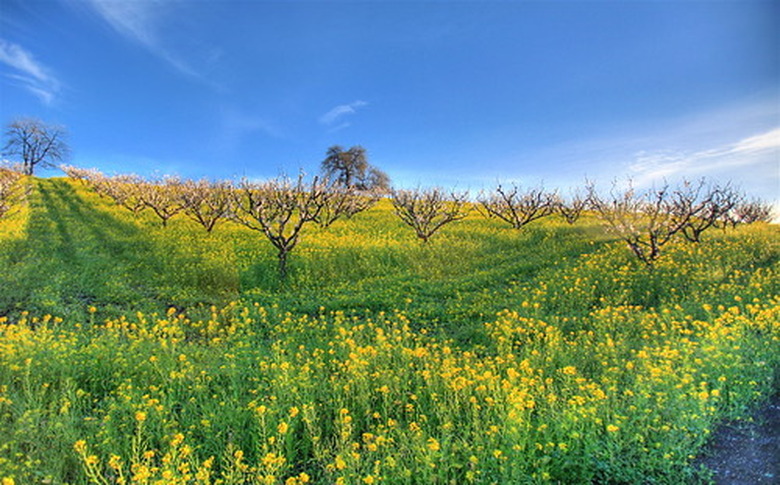Mustard Plant Facts
Mustard plants possess yellow flowers with four petals that join at a narrowed base. These plants produce a plethora of rounded seeds that spread rapidly over an area, turning entire landscapes yellow when the plants bloom in the spring and early summer.
Size
In the United States, there are about six separate species of mustard plant, ranging in size from 1 foot tall to as high as 6 feet.
Benefits
Mustard oil is used for medicinal purposes and in soaps, while the greens of some mustard plants are edible.
Geography
North Dakota leads the United States in mustard production. The Canadian provinces of Alberta, Saskatchewan and Manitoba grow much of the world's mustard crop.
Effects
One type of mustard plant non-native to this nation is garlic mustard, which can take over the woodlands, growing so quickly and tall that wildflowers such as bloodroot and trillium cannot prosper.
- Mustard plants possess yellow flowers with four petals that join at a narrowed base.
- One type of mustard plant non-native to this nation is garlic mustard, which can take over the woodlands, growing so quickly and tall that wildflowers such as bloodroot and trillium cannot prosper.
Types
Mustard plants suffer from the effects of an assortment of diseases, which include white rust, stalk rot, downy mildew and leaf spot.
Mustard Plant Look Like?
No hamburger or hotdog is complete without it, and no summer picnic is fully prepped without adding a jar to the basket. The tasty condiment comes from a mustard tree or mustard plant, and many home gardeners have taken to growing mustard seeds to admire the sharp, radiant yellows of the mustard flower. Despite its diminutive size, one tiny mustard seed can produce a mustard tree or mustard plant that's 5 to 6.5 feet tall, towering over the other plants in your garden. An annual mustard plant can grow up to 6 feet but will only last one season. The African mustard bush feeds livestock and is used for medicinal purposes. Mustard seeds are known for being tiny. White mustard seeds that are typically grown in gardens will be white or light yellow like their flowers. These are sometimes called mustard greens or leaf mustard.) Even the mustard flower is edible, although they can be very bitter and not as tasty as the leaves and, therefore, not used as often as a food source.
- Mustard plants suffer from the effects of an assortment of diseases, which include white rust, stalk rot, downy mildew and leaf spot.
- The tasty condiment comes from a mustard tree or mustard plant, and many home gardeners have taken to growing mustard seeds to admire the sharp, radiant yellows of the mustard flower.
References
- Mustard:Purdue University
- "Weeds";Alexander Martin;1987
- Encyclopaedia Britannica: Mustard Plant and Condiment
- Namibia Travel Shop: Mustard Bush
- Plant Village: Mustard
- What's Cooking America: Edible Flowers
- Gardening Know How: Planting Mustard Seeds: How To Grow Mustard Seed Plants Mustard
- Gardening Know How: Planting Mustard Greens – How To Grow Mustard Greens
